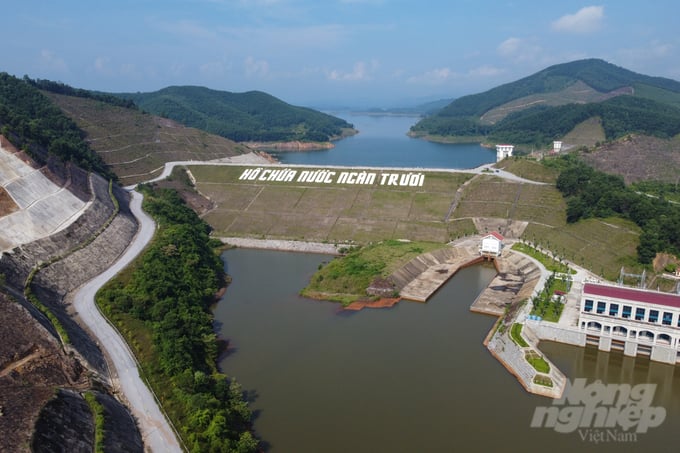November 27, 2025 | 14:43 GMT +7
November 27, 2025 | 14:43 GMT +7
Hotline: 0913.378.918
November 27, 2025 | 14:43 GMT +7
Hotline: 0913.378.918
During the Forum on "Improving the effectiveness of information and warning, ensuring safe operation of irrigation dams and reservoirs in the new situation", Mr. Luong Van Anh, Deputy Director of the Department of Water Resources, noted that the nation has about 7,300 irrigation dams and reservoirs, including 592 dams and more than 6,700 reservoirs, with a total storage capacity of over 15.2 billion cubic meters.
The Ministry of Agriculture and Rural Development (MARD) actively manages four essential reservoirs and one inter-provincial reservoir, while eight other inter-provincial reservoirs have been delegated to local authorities for administration.

Mr. Luong Van Anh, Deputy Director of the Department of Water Resources sharing that the management and operation of irrigation works have faced many difficulties. Photo: Tung Dinh.
Local governments manage more than 6,700 reservoirs. Among them, 63 provincial-level organizations oversee over 2,300 medium and large reservoirs (34%), while district and commune-level units are responsible for more than 4,200 smaller reservoirs (64%). In some cases, land clearance for reservoirs is limited to the typical water level rather than the designated flood level, resulting in encroachments such as residential buildings and tree planting.
These efforts diminish flood storage capacity and impair flood discharge capacities in significant reservoirs such as Nui Coc, Vuc Mau, Ayun Ha, La Ring, and Dau Tieng. Moreover, livelihood activities in reservoir locations exert further strain on reservoir operations. Irrigation reservoirs must function following approved operating guidelines.
Nonetheless, hardly 28% of reservoirs now use such methods. Many activities depend on forecasts of the weather because of insufficient rainfall monitoring equipment in reservoir catchment regions. Numerous jobs remain inadequately supported, particularly for small and medium-sized reservoirs. Key deficiencies include emergency response plans (28%), safety inspections (9%), operating procedures (28%), installation of meteorological monitoring equipment (17%), maintenance and upgrades (27%), and floodplain mapping (5%).
Current regulations classify reservoir regions as parts of water infrastructure, resulting in issues when reservoir borders extend under dam crests. Moreover, mining operations in restricted zones need specific authorizations and compliance with local and national mineral planning, which remains outdated in several locations. Reservoir aquaculture is governed by many legal frameworks, including water resource legislation, land statutes, and asset management restrictions.
Operators are required to pay fees for water use and land leases, forcing the implementation of simplified procedures to efficiently assist users. Following Typhoon No. 3, the number of seriously damaged reservoirs rose by 68. operating limits include outmoded operating methods, some over a decade old, and difficulty in managing reservoirs with human activity in their catchment areas or inhabited downstream regions.

Current reservoir operations are primarily based on weather forecasts due to the lack of rainfall measurement equipment in reservoir catchment areas. Photo: Tung Dinh.
Regarding specialized meteorological and hydrological monitoring and reservoir operation supervision, 17% of reservoirs have been equipped with specialized meteorological and hydrological monitoring devices and reservoir operation supervision equipment. These devices play a crucial role in supporting the management and operation of reservoirs following approved operational procedures and real-time conditions. However, many large reservoirs have yet to be fully equipped with these devices, or the installed equipment has become damaged and is no longer functional.
Regarding dam and reservoir design standards, within the framework of the World Bank (WB) project, depending on the number of households threatened downstream, 446 reservoirs have been designed to account for flood frequencies for testing (0.1% to 0.01%) based on international practices.
However, most irrigation reservoirs have been designed according to Vietnamese standards with more common flood frequencies (1.0% to 0.1%). Therefore, under the current extreme rainfall and flooding conditions, reservoirs not designed to international flood frequency standards face a higher risk of dam safety failures during severe floods that exceed the design or test frequencies.
However, with the growing frequency of intense rainfall and floods, reservoirs not planned to international standards face rising risks of breaking down. Only 17% of reservoirs had emergency response strategies, leaving densely populated downstream regions vulnerable to significant effects during disasters. The management and maintenance of irrigation reservoirs in Vietnam encounter several problems, including antiquated infrastructure, inadequate finance, and legal and procedural limitations. Resolving these concerns necessitates enhanced monitoring systems, revised operating regulations, and more finance to guarantee the secure and effective management of reservoirs, particularly amid increasing severe weather events.
Translated by Linh Linh

(VAN) After the institutional merger, Da Nang possesses significant forest-carbon reserves and is proactively engaging in the carbon market, creating a new revenue stream.

(VAN) An Giang strengthens communication against IUU fishing, increases inspections and sanctions, and is determined to remove the EC’s “yellow card” while developing a sustainable fisheries sector.

(VAN) As green transition becomes a global trajectory, Viet Nam’s biggest challenge is not only technology and models, but how to ensure that capital flows reach the right beneficiaries.

(VAN) The Ministry of Agriculture and Environment must spearhead the construction of green governance, spanning decision-making processes and investment standards to policy evaluation mechanisms.

(VAN) The Agriculture and Environment sector of Khanh Hoa has achieved numerous milestones over the past 80 years, contributing significantly to the goal of establishing the province as a centrally governed city by 2030.

(VAN) Viet Nam is entering the pivotal period of 2025-2030, moving toward the formulation of the Remote Sensing Law, which will establish a legal foundation for the development of national digital data.

(VAN) The agricultural sector is finalizing the strategic framework for emission reduction, setting the goal of sharply cutting methane and 403.7 million tons of CO2 equivalent and moving toward Net Zero by 2050.